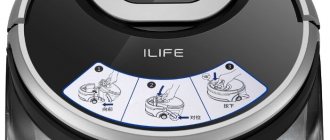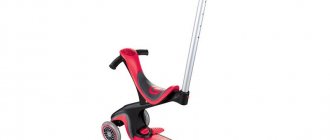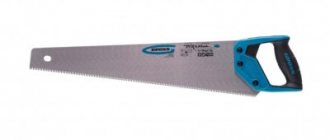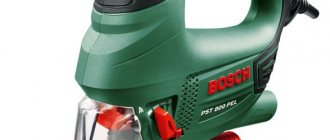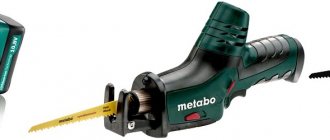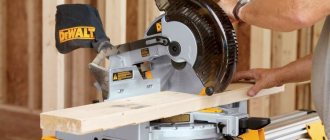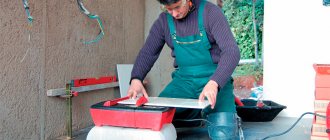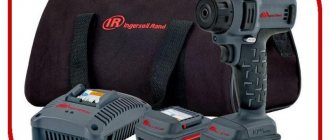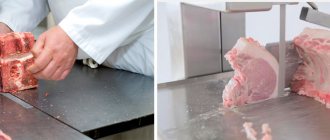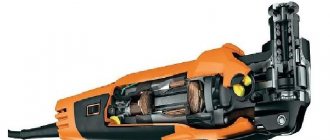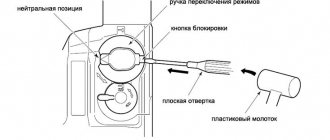Choosing the right tool
First, you need to choose the right power tool based on your own needs. It is important to understand that the more powerful the device, the greater its weight. This will directly affect the further ease of use. Therefore, you should not purchase a tool paying attention solely to its power.
When choosing, you need to pay attention to some useful additions to the device. For example, lighting and airflow can actually often come in handy when working with a jigsaw. It is also recommended to purchase models with stepwise speed control, electronic stabilizer, and pendulum stroke. All this will greatly simplify woodworking.
Before paying money for a tool, it is recommended to hold it in your hands and make sure it is comfortable. Some stores allow customers to try out a new tool on site, so it’s a good idea to take advantage of this opportunity.
Briefly about the tool
A jigsaw is a mini saw that makes human work easier. The tool processes wood and its derivatives, metal blanks and plastic. The principle of operation is to transmit oscillatory movements in a vertical plane to the cutting tool. Moving up and down, in parallel with the translational movement, the jigsaw makes a cut in the semi-finished product.
In addition to vertical reciprocating movements, some power tool models are equipped with a pendulum stroke. Feature - the file moves in a vertical plane and simultaneously back and forth. That is, in the working position, the teeth are in contact with the material. In the counter-move, the file moves back, interrupting the interaction.
Design features
Using a jigsaw correctly means, first of all, knowing its structure and technical capabilities.
Consists of:
- Bed . It is the base on which the remaining elements of the tool are attached. The platform must be level, rigid and strong - the correct direction of the file depends on this, and, accordingly, the ability to make an accurate cut. In addition, the massiveness of the base eliminates vibrations that occur during operation.
- Frame . It combines the main components - engine, gearbox, saw attachment system, control elements. It is made in two types - with an arched (bracket-shaped) handle or a “fungal” (“iron”) handle. Ergonomics, the ease of grasping the tool by hand, indirectly affects the performance of operations with minimal tolerances for deviation.
- Blade fastening mechanism . Reliability of fixation, absence of free movements (backlash), maintaining the direction in one plane is one of the technical capabilities for precise cutting.
Useful equipment
A number of jigsaw accessories help to create an even seam:
- Compass stop . Required for precise cutting of a circle.
- Parallel side stop . Designed for straight cutting. The straightness of the seam depends on the condition of the side (supporting) side.
- Guide bar . Allows you to make precise straight cuts at a distance of 20 centimeters or more.
- Platform overlay. Reduces the coefficient of friction and increases sliding on the surface of the workpiece.
- Anti-scratch liner. Reduces the likelihood of chipping. Useful for processing laminated materials.
Characteristics affecting cutting accuracy
A jigsaw has certain characteristics that indirectly or directly affect the nature of the cut. For clarity, the indicators are summarized in a table.
| Characteristic | Note |
| Power | Affects productivity, speed and depth of cut. That is, it is easier to cut a workpiece with a more powerful unit without applying external force than with a weak one. The likelihood of vibration, bending of the file, and yaw to the side will be reduced |
| Speed (rpm) | The indicator is important for choosing a cutting mode for a specific material. Affects cutting speed. High – for soft wood, low – for steel |
| Smooth start | The function allows you to start the cutting operation smoothly, without jerking or impact. The moment the seam is formed depends on the initial cut - whether it hits the trajectory exactly or at an angle. |
| Weight | Increasing the weight of the tool reduces the influence of vibration and sideways movement |
| Saw stroke | Directly related to power. When processing thick parts, weak units operate in peak mode, at the limit of their capabilities. The consequence is increased vibration, bending of the file, departure from the trajectory |
| Pendulum stroke | Speeds up the cutting process, but degrades the quality of the cut |
| Speed adjustment | Allows you to select the optimal cutting mode in accordance with the characteristics of the workpiece material |
| Maintain speed under load | The stability of the movement of the cutting tool during the processing of the material allows you to create a smooth sawing seam without chipping or leaving the trajectory |
| Airflow direction | By blowing the cutting zone with an air flow from a fan cooling the engine, the sawdust is swept away. Improved visibility of the cutting point |
| Illumination of the cutting area | Illumination of the working area increases visual control over the cutting direction |
An important point is that no matter what characteristics the tool has, poor-quality assembly can nullify the capabilities of the device.
Cutting tool
The second most important element of a jigsaw affects the cutting accuracy.
File parameters:
- Canvas length . In addition to power, it determines the thickness of the workpiece. Size mismatch leads to peak operating conditions and vibration. It is very likely that the seam will break, causing an increase in width and the formation of uneven edges.
- Web width . Increasing the size helps maintain the cutting direction. Narrow files are convenient for making curved lines.
- Thickness of the canvas. Increases the rigidity of the cutting device, reducing the likelihood of being pulled to the side. The perpendicularity of the file to the surface of the workpiece is maintained. The quality of the cut increases.
- Tooth pitch. Determines the type of material being processed. The 3~6mm setting is for rough wood processing. 2~3 mm – clean cut of laminate, furniture panels, parquet boards. Up to 1 mm – metal processing. For the convenience of the consumer, markings are applied on the side - the inscriptions “wood”, “metal”, etc.
- Set of teeth. Allows you to create a seam size that does not interfere with the movement of the fabric. There is no possibility of jamming or distortion.
- File material. Affects the strength, rigidity and sharpness of the teeth. Distortion of any parameter affects the quality of the seam.
Files are produced for working on ceramics, glass, and polymers. The correct choice of cutting tool is one of the keys to accurate cutting. An additional factor is the sharpness of the teeth. A dull saw cannot make an even cut.
Processed material
The type of material being processed and its thickness greatly influence the quality of processing. Using a wood saw to cut pine, larch or oak blanks leads to different results due to the strength properties of the wood.
Another example is working with different types of steel - stainless steel and black iron. Here there is a difference in strength, viscosity, and fragility.
Selection of cutting blade
For an even cut, it is important to choose the right cutting blades. They are classified according to the length and frequency of the teeth. Regardless of the type of fabric, it is better to give preference to trusted manufacturers. Basically, blades of models No. 3, No. 5, and No. 7 are purchased for working with a manual jigsaw, but there are exceptions.
Classification of paintings:
- standard - files with teeth of the same size, oriented in the same direction at an equal distance;
- blade with a missing tooth - the cutting element has one tooth missing in turn. This increases the cutting speed and reduces the heating of the file.
- double teeth - the speed of working with such a blade is noticeably reduced, but the quality of the cut is many times better;
- reversible - thanks to the teeth located on the reverse side of the blade, you can cut the material without chipping.
In what cases is a precise cut needed?
Performing a technological operation for sawing or creating a figured cut involves the formation of a line that corresponds to the task. That is, the cut must be smooth with minimal tolerances for deviation.
The following requirements are necessary:
- Ensuring tight abutment of mating surfaces.
- Creating minimal gaps.
- Formation of the correct geometry of the structure from machined parts.
- Attractive appearance of the cutting line and parts in general.
Marking the cut line
For a neat cut, marking the cut line plays a very important role. The first step is to use a ruler and pencil to draw all the necessary lines according to the required dimensions. If shaped cutting of material is required, you should initially apply it to paper and then transfer it to the material using carbon paper.
Next, you need to use a straight strip as a guide. Without it, the jigsaw blade can easily move to the side, and the workpiece will be damaged. Some models of jigsaws have a laser beam, which helps to orient the tool more evenly, but you should not neglect the guide rail.
To cut out a circle, markings are made according to a pre-made stencil. A hole is drilled in the center of the circle, and the canvas is drawn from it to the edges of the marking and cut around the perimeter.
Components of a jigsaw
The correct use of this tool also depends on the owner’s knowledge of the composition of the electric jigsaw. Since Bosch released its first copy of this multifunctional device into the world in 1944, its components have undergone many changes, but its basic design has remained unchanged. So, a jigsaw has the following components:
- gearbox (its body must be made exclusively of metal, since the rubber body calls into question the strength of the tool, as it impairs heat transfer);
- sole (the best option for the sole material is cast metal, because some jigsaws have a plastic plate, which does not have a good effect on the quality of work);
- motor housing (a jigsaw is considered good if this particular part is made of the highest quality, strongest material, because this is where the motor is located);
- lever.
Technology for making an even cut
To ensure an accurate cut, you should adhere to some nuances:
- Do not put too much pressure on the device during operation. In this case, the canvas may break, and defects may appear on the material.
- When cutting a steel sheet, you need to use a powerful tool and work at maximum speed. When heated by friction, the metal will become more malleable.
- Working with plastic, org. When working with glass or metal, it is important to take periodic breaks from working so that the cutting element has time to cool down.
- To avoid melting the plastic when cutting it, you should work with this material only at low engine speeds.
- To ensure accurate figure cutting, you should choose a narrow blade with small teeth.
All these recommendations will help you learn how to cut smoothly with a jigsaw, even if it seems to you that this is impossible.

